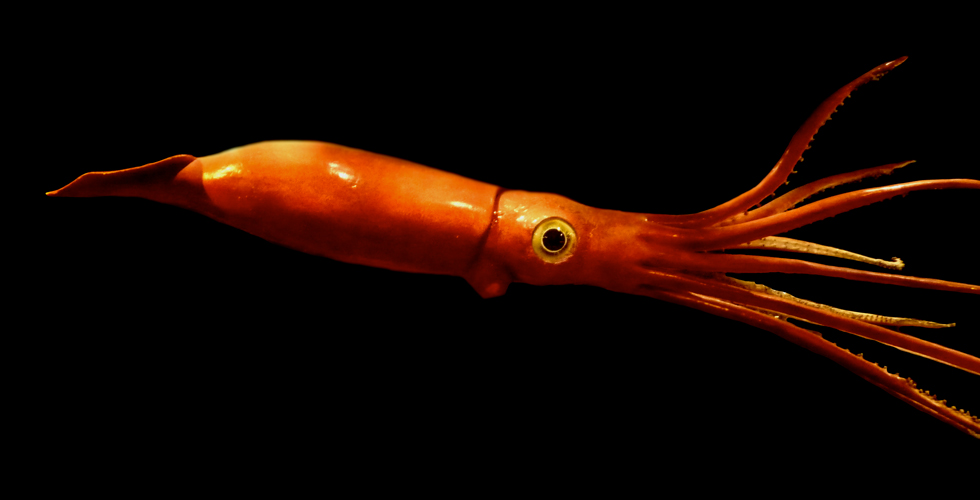Jumbo Squid Attack the West Coast

Citron / CC-BY-SA-3.0 / Wikimedia Commons
A type of squid native to the Pacific coast of Mexico is attacking dolphins and tuna as the species expands into new waters as far north as Alaska. Now for the time marine biologists can watch these battles from a boat above, monitoring the squids' movements with acoustic technology similar to the equipment used by fisherman to follow school of fish.
Echo-locating sensors developed at Oregon State University and the Monterey Bay Aquarium Research Institute (MBARI) in California have revealed large numbers of Humboldt squid just off Mexico's Pacific coast, in an area where the squid are commercially fished. This tracking system could soon shed some light on whether the squid population's spread out of Mexican waters and up the coastline is due to global warming -- and whether it poses a potential threat to U.S. fisheries and ecosystems.
Known to Mexican fishermen as "el diablo rojo" (the red devil), the Humboldt squid is historically found in the warm waters of the Sea of Cortez. The voracious predator -- which can grow to six feet in length -- eats zooplankton, fish and even cannibalizes other Humboldt squid.
"When you bring one up on deck, it looks like an alien ... their suckers have little barbules that scratch you, like pulling out of a berry patch," says Tom Mattusch, a fisherman from Northern California who calls the animal by its common name, the flying jumbo squid.
In recent years, Mattusch and other fisherman have spotted the arrow-shaped squid in U.S. waters. Risso dolphin carry wounds from squid encounters, and battle-scarred black cod are frequently caught with bits of tentacles in their stomachs.
Studies by marine biologists, who tag the animals or watch them with video cameras on submersibles, confirm that the squid are moving farther north up the Pacific coastline. Carcasses have washed ashore as far north as British Columbia and Alaska,and as far south as the southernmost tip of Chile.
To estimate how many squid are out there and to decide if they pose a threat to local fisheries, Kelly Benoit-Bird of Oregon State University has adapted a piece of a equipment used by fishermen to spot schools of fish. These echo-location devices -- which detect animals using bounced sound waves, like a bat's sonar -- were once thought to be impractical for monitoring cephalopods like squids, which have a density close to that of seawater.
Two years ago, though, the group figured out how to bounce sounds off captured squid. Now they can use cones of sound broadcast from the bottom of a boat, shaped like flashlight beams, to detect the movement of the meter-long monsters in the wild in three dimensions.
According to data collected from 2007 and 2008, the squid population can reach up to 25,000 squid per cubic kilometer in their native waters off the Mexican coast. “The surprising thing is how high this number is,” says Benoit-Bird, who presents her findings at this week's meeting of the Acoustical Society of America in Portland.
Her colleague, MBARI's William Gilly, is using this data to calculate the total number of squid in the area to consult with Mexican officials about regulations on how many squid the local fishermen should be allowed to catch.
Their next project will examine waters off the coast of Californian to determine the number of squid that may have migrated northwards.
Meanwhile, others debate why the squid’s habitat is extending in the first place.
Some, like George Watters of the National Oceanic and Atmospheric Administration (NOAA), point to climate change. The first recent sighting of a Humboldt squid in California coincided with the strong El Niño event in 1997, a massive transfer of heat over the Pacific Ocean that changed weather patterns across North America. Though the squid are resilient to temperature variations, the warming oceans could have a bottom-up effect by changing the oxygen content of the water, the distribution of microorganisms, and thus the distribution of the food that the squid eat.
Other scientists, like Bruce Robison of MBARI, offer a "top-down" explanation instead that blames the over-fishing of large predatory fish. Tuna and billfish eat both Humboldt squid and the fish that the squid prey on. The depletion of these giant fish, which grow and mature over years, may allow the squid -- which mature in 6 to 8 months -- to rapidly movie into new niches.
"We know how much an individual squid can eat," says Gilly. "If there are a lot of them out there, it would have a huge impact."
Devin Powell is freelance science journalist based in New York. His stories have appeared online and in print at Nature, Scientific American, the Washington Post, Science News, WIRED, The Best American Science Writing 2012 anthology, and elsewhere.

